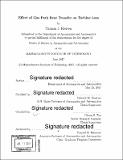| dc.contributor.advisor | Edward M. Greitzer and Choon S. Tan. | en_US |
| dc.contributor.author | Kleiven, Thomas J. (Thomas John) | en_US |
| dc.contributor.other | Massachusetts Institute of Technology. Department of Aeronautics and Astronautics. | en_US |
| dc.date.accessioned | 2017-12-05T19:14:04Z | |
| dc.date.available | 2017-12-05T19:14:04Z | |
| dc.date.copyright | 2017 | en_US |
| dc.date.issued | 2017 | en_US |
| dc.identifier.uri | http://hdl.handle.net/1721.1/112466 | |
| dc.description | Thesis: S.M., Massachusetts Institute of Technology, Department of Aeronautics and Astronautics, 2017. | en_US |
| dc.description | Cataloged from PDF version of thesis. | en_US |
| dc.description | Includes bibliographical references (pages 117-118). | en_US |
| dc.description.abstract | This thesis presents an assessment of the impact of gas path, i.e., streamtube-to-streamtube, heat transfer on aero engine turbine loss and efficiency. The assessment, based on the concept of mechanical work potential [19], was carried out for two model problems to introduce the ideas. Three-dimensional RANS calculations were also conducted to show the application to realistic configurations. The first model problem, a constant area mixing duct, demonstrates the importance of selecting a fluid component loss metric appropriate to the purpose of the overall system in which the component resides. The phenomenon of thrust increase due to mixing is analyzed to show that system performance can increase even though there is a loss of thermodynamic availability. Gas path heat transfer affects mechanical work potential, and thus turbine loss, through a mechanism called thermal creation [19]. The second model problem, an inviscid heat exchanger, illustrates how thermal creation is due to enthalpy redistribution between flow regions with different local Brayton efficiency. Heat transfer across a static pressure difference, or between gases with different specific heat ratios, can cause turbine efficiency to increase or decrease depending on the direction of the heat flow. Three-dimensional RANS calculations have also been interrogated to define and determine the thermal creation, and thus the losses, in a modern two-stage cooled high pressure turbine. At representative engine operating conditions the effect of thermal creation was a 0.1% decrease in efficiency, with the thermal creation accounting for 1% of the overall lost work. Introducing coolant flow into the main gas path increased the loss from thermal creation in the first stage by 84% and decreased the loss from thermal creation in the second stage by 8%. | en_US |
| dc.description.statementofresponsibility | by Thomas J. Kleiven. | en_US |
| dc.format.extent | 118 pages | en_US |
| dc.language.iso | eng | en_US |
| dc.publisher | Massachusetts Institute of Technology | en_US |
| dc.rights | MIT theses are protected by copyright. They may be viewed, downloaded, or printed from this source but further reproduction or distribution in any format is prohibited without written permission. | en_US |
| dc.rights.uri | http://dspace.mit.edu/handle/1721.1/7582 | en_US |
| dc.subject | Aeronautics and Astronautics. | en_US |
| dc.title | Effect of gas path heat transfer on turbine loss | en_US |
| dc.type | Thesis | en_US |
| dc.description.degree | S.M. | en_US |
| dc.contributor.department | Massachusetts Institute of Technology. Department of Aeronautics and Astronautics | |
| dc.identifier.oclc | 1011038597 | en_US |
